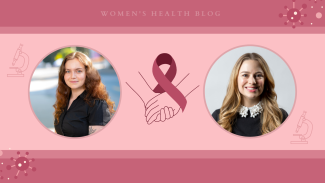Interviewees: Tetiana Povshedna, PhD Student (University of British Columbia Department of Pathology and Laboratory Medicine); Marie-Soleil Smith, PhD Candidate (University of British Columbia Department of Pathology and Laboratory Medicine) Authors/Editors: Romina Garcia de leon, Shayda Swann (Blog Co-coordinators).
Published: March 10th, 2023
Could you briefly explain what your research is about?
Tetiana: My research is part of The British Columbia CARMA-CHIWOS Collaboration (BCC3) Study, which seeks to better understand the process of aging among women living with HIV by examining the interplay between biological, clinical, and socio-structural determinants of health. In my thesis, I examine the associations between latent viral infections, inflammation, markers of cellular aging, and risk of comorbidities in women living with HIV. My work also explores chronic pain, which is often referred to as an “invisible disability” by community members due to its negative effects on all aspects of life and, in the context of HIV, treatment adherence and care. By raising awareness of this important comorbidity, we hope to improve chronic pain care for women living with HIV.
Marie-Soleil: My field of study lies at the cross-section of women’s health, HIV research, and the safety of medications taken while pregnant. My main project utilizes human embryonic stem cells as a model of an early developing embryo to find the safest antiretroviral regimens for use during pregnancy.
What led you to become interested in studying HIV and women's health?
Tetiana: Historically, the majority of HIV research has involved men, thus limiting generalizability of findings to women, who constitute >50% of people living with HIV globally. The specific needs of half of the population of people living with HIV haven’t been addressed for years, and it’s only been changing recently. After my initial interest in HIV and aging, I was lucky to join the Côté Lab and get involved with community-based women-centered research. We have an amazing team of scientists, clinicians, and community members working together to answer women-specific questions in a meaningful way.
Marie-Soleil: My interest in HIV research stemmed from my time at the BC Centre for Disease Control working as a co-op student. During my time there, my eyes were opened to the wide world of infectious disease research, particularly the more classically stigmatized sexually transmitted infections. I was energized by my brief stint in the field and was so grateful to find an opportunity to continue this important research in Dr. Côté’s lab. Although it was not intentional, I am very lucky to have landed in a lab that puts a major emphasis on women’s health research. This is especially true as women are now disproportionately affected by HIV.
Could you talk more about why clinical and cellular research are important?
Tetiana: It takes decades of diligent basic science research to advance a field to the point when the results are tangible in a clinical setting. While my work involves human specimens and survey data, a lot of other researchers in Côté Lab work with cellular models. Both types of work provide valuable data that can often guide clinical decision-making to improve quality of life for people living with HIV.
What does your typical day look like?
Marie-Soleil: My days vary greatly depending on upcoming deadlines and whether I have ongoing cell culture experiments. If I do not have any experiments, I spend my day on the computer analyzing data, reading papers, and working on manuscripts. Experiment days vary widely depending on if it is a day where I am starting up the experiment, a maintenance day where I change the cell culture media, or a big analysis day where I harvest and prep the cells for subsequent flow cytometry. The cell culture experiments I conduct require daily lab work, so I try my best to spread my other work out throughout the week in an attempt to avoid burnout.
What impact do you hope to see from your work in the future?
Tetiana: A powerful message coming from the community of people living with HIV is “Nothing about us without us is for us”. I hope that research projects that meaningfully involve community, such as BCC3, will address the true needs of the people we’re trying to serve. Ultimately, I hope that our study findings will improve care and everyday life for women living and aging with HIV, and also affect the way the research is conducted in this field.
Marie-Soleil: My research provides information on the relative toxicity of antiretrovirals in an in vitro model, which may help inform and guide future human trials and strategies for the treatment of HIV in women of reproductive age. I would like to highlight the importance of utilizing relevant preclinical models and including people who become pregnant in clinical trials that assess medications that will undoubtedly be taken during pregnancy. Ultimately, I hope there is a future where all women have access to medications with sufficient pregnancy safety data.
Where can people find out more about your work?
Tetiana: You can learn more about the BCC3 study on our website.
Marie-Soleil: @MarieSunSmith on Twitter
